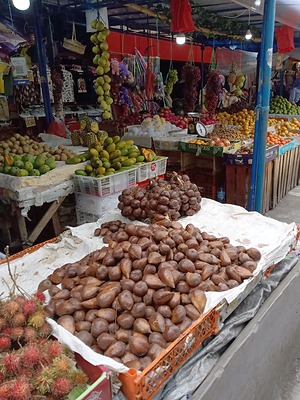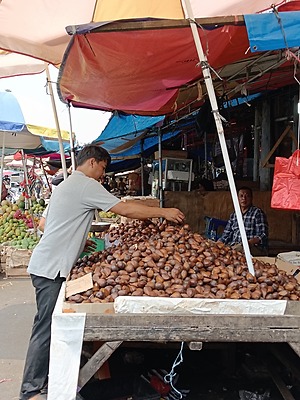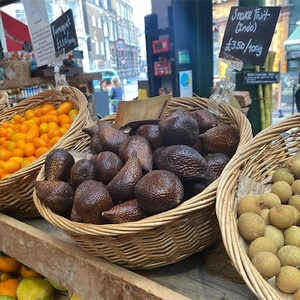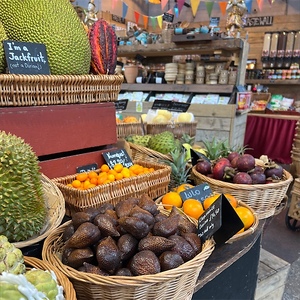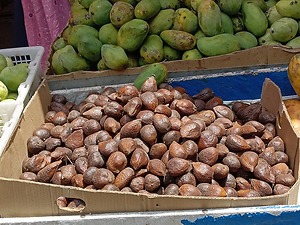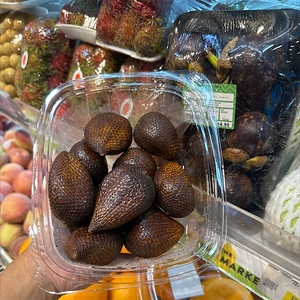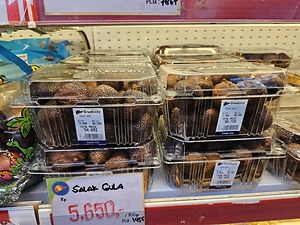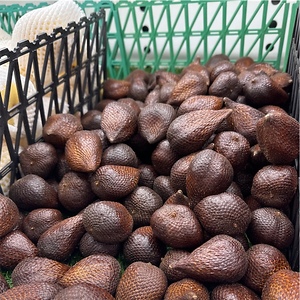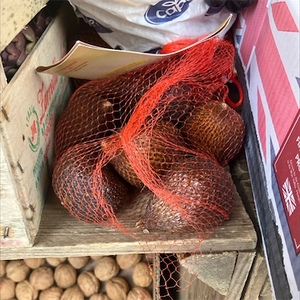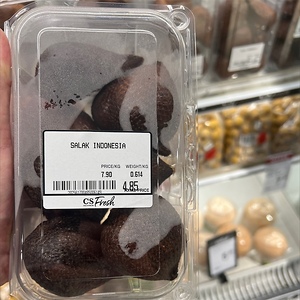

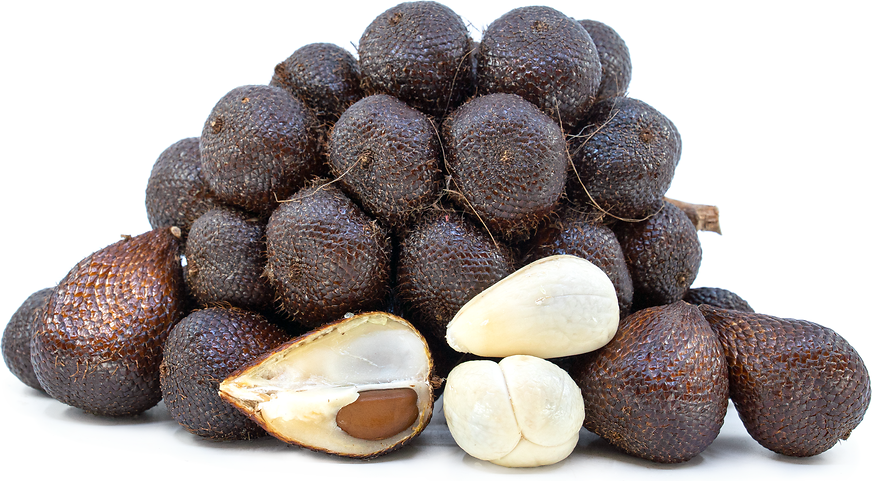
Snake Fruit
Estimated Inventory, ea : 0
This item was last sold on : 09/08/24
Description/Taste
Snake fruits are typically small in size, averaging 5 to 8 centimeters in diameter and 2 to 10 centimeters in length, and have a bulbous, curved base tapering to a pointed, narrow tip. The fruits sometimes resemble pears with a pyriform shape, and the surface is covered in tiny, overlapping triangular scales that are shiny, semi-smooth, and hard. This scaly skin also occasionally bears little spikes that may prick and cause irritation, and the scales range in color from dark brown, red-brown, to golden brown, depending on the variety. Despite the fruit’s impenetrable appearance, the skin is thin and easy to peel once opened. Underneath the surface, the flesh is divided into three white, ivory, and pale yellow lobes resembling elongated garlic cloves. The flesh is encased in a thin, almost unnoticeable white membrane that can be left intact or peeled before consumption, based on preference, and it is said the membrane may add a slightly astringent taste. Snake fruit flesh is firm, crisp, and succulent with an apple or raw garlic-like crunch. Each variety varies in consistency, and some will have a chalky, flaky, and drier texture, while others are spongy, juicy, and chewy. Each lobe also encases a dark brown, hard, inedible seed. Select Snake fruits that are firm, fragrant, and have uniform coloring. Ripe fruits will have a sweet, earthy, and slightly musky scent. Snake fruits are edible raw and have a complex sweet, tangy, and acidic taste said to have a flavor reminiscent of a blend of bananas, apples, pineapples, and jackfruit. The flesh is initially sweet and finishes with acidic notes.
Seasons/Availability
Snake fruit is available year-round in Southeast Asia.
Current Facts
Snake fruit, botanically classified as Salacca zalacca, is a type of palm fruit belonging to the Arecaceae family. The species is native to Southeast Asia, and the fruits grow in clusters at the base of an evergreen palm that reaches up to three meters in height. The small palms bear fruit approximately 3 to 4 years after planting, and the fruits are challenging to harvest as the tree is covered in sharp spines. Southeast Asia has around thirty species of Snake fruits, but many of the species are bitter when raw and are used solely in cooking. Salacca zalacca is one of the most commercially grown species of Snake fruit and is popular for its sweet and sour taste. Snake fruits are also known as Salak, Salacca, Snake Palm, Snakeskin fruit, Lizard-skinned fruit, and Sala. The fruits earned their serpent-centric moniker from their thin, scale-like skin, similar in appearance to the well-known reptile. Since ancient times, Snake fruit has been consumed as a food source, and the fruits are traditionally eaten fresh as a flavorful snack throughout Southeast Asia. The fruits are also incorporated in various cooked dishes and complement sweet and savory preparations.
Nutritional Value
Snake fruit is a source of calcium to build strong bones and teeth, iron to develop the protein hemoglobin for oxygen transport through the bloodstream, potassium to balance fluid levels within the body, and magnesium to maintain healthy organs. The fruits also provide fiber to regulate the digestive tract, phosphorus to repair tissues, vitamin C to boost the immune system, and other nutrients, including manganese, copper, vitamin A, zinc, folate, riboflavin, and niacin. In Indonesia, Snake fruits are called the “Fruit of Memory” as their potassium and pectin content is thought to support memory and overall brain health by improving blood flow. The fruits are also thought to jumpstart the metabolism, lessen heartburn, and have antidiarrheal properties. Snake fruits should only be consumed in small quantities, as eating an excess may cause constipation. Local Southeast Asian superstition says that the thin membrane enveloping the fruit’s flesh is thought to prevent constipation, and if large numbers of the fruits are going to be eaten, the membrane should be consumed and not removed.
Applications
Snake fruits have a musky, sweet, tangy, and subtly acidic taste suited for fresh or cooked preparations. The fruits must be washed and peeled before consumption, and it is easiest to remove the skin by pinching the tip, creating a break. The tip can be carefully pulled off, and the remaining skin can be peeled against the grain of the scales. It is important to note that the fruits should be handled carefully as they are often covered in sharp, small spines. Once peeled, the white flesh can be consumed out of hand, discarding the center brown seed. Some varieties of Snake fruits have edible seeds when young, but in general, the seeds are not eaten. Snake fruits can be sliced into salads, mixed into fruit bowls, or used as a topping over rice-based dishes. In Indonesia, young Snake fruit is typically added to rujak, a spicy condiment comprised of chopped fruits, vegetables, herbs, and aromatics. Snake fruits can also be eaten as an on-the-go snack. Street vendors in Thailand often peel and sell the fruits ready to be eaten with a mixture of salt and sugar to enhance flavoring. In addition to fresh preparations, Snake fruits can be added to stir-fries and curries, dried into chips, or pickled or canned for extended use. The fruits also complement sweet preparations and are simmered into syrups, jams, and jellies, incorporated into pies and ice cream, or boiled with sugar into candies. Beyond culinary dishes, Snake fruits can be blended with ice into a drink, made into wine, or pureed with other tropical fruits to make a smoothie. Snake fruits pair well with nuts such as peanuts, almonds, and cashews, fruits such as pineapples, mangoes, jackfruit, and passion fruit, and aromatics including shallots, garlic, ginger, and chile peppers. Whole, unpeeled Snake fruit should be immediately consumed when ripe for the best quality and flavor. The fruits can also be stored in the refrigerator for a few days.
Ethnic/Cultural Info
Snake fruits are a customary fruit given as a sign of hospitality in Indonesia. The native fruits are widely sold throughout local Indonesian markets and are popular at restaurant buffets. The compact palm trees are also planted in rows to form a dense thicket as a natural property line. Snake fruit palm trees are covered in thorns and are almost impenetrable once they mature and grow into tightly arranged groupings. The palm leaves are also woven into floor mats, baskets, and hats, and various crafts are made from the fronds and sold as an additional source of income. In Indonesia, there are two main types of Indonesian Snake fruits: Salak pondoh, from the island of Java, and Salak Bali, from the island of Bali. There is also a unique strain of extra small and extra sweet Salak Bali, appropriately named Salak gula pasir, meaning “sand sugar.” It is often simply called Sugar Salak, and it garners the highest price on the island. Not only is Sugar Salak enjoyed fresh, but it can also be fermented into a sweet, strong, dry, honey-colored wine.
Geography/History
Snake fruits are native to Indonesia and have been growing wild since ancient times. Various species of Snake fruits also spread throughout Southeast Asia in the early ages, and the palm is a natural occurrence in forests and swamps. Snake fruits thrive in lowland tropical regions below 500 meters in elevation. The palms typically grow in shady spots and are found in areas of high rainfall or near water, as their roots are shallow and require frequent irrigation. Historically, Snake fruits have remained localized to Southeast Asia but have spread in small quantities into India, China, Australia, and parts of the South Pacific. Today, Snake fruits are still growing wild and are cultivated mainly in Indonesia, Malaysia, Singapore, and Thailand. They are also found in other regions of Southeast Asia. Fresh fruits are sold through local markets or are foraged from wild plants.
Recipe Ideas
Recipes that include Snake Fruit. One
| The Snake Fruit |
|
Pickled Snake Fruit |
| Ang Sarap |
|
Enjoying Rujak at Kuta Beach |
Podcasts



